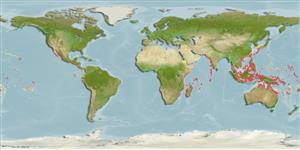分类 / Names
俗名 | 同种异名 | Catalog of Fishes(属, 种) | ITIS | CoL | WoRMS | Cloffa
Teleostei >
Gobiesociformes (Clingfishes) >
Gobiesocidae (Clingfishes and singleslits) > Diademichthyinae
Etymology: Diademichthys: Greek, diadema = diadem, regal fillet of the Persian kings, a crown, 1579 + Greek, ichthys = fish (Ref. 45335).
More on author: Sauvage.
Environment: milieu / climate zone / depth range / distribution range
生态学
海洋 礁区鱼类; 深度上下限 3 - 20 m (Ref. 90102). 热带
Western Indian Ocean: Oman (Ref. 11441) and Mauritius (Ref. 33390). Western Pacific: Indonesia to Fiji and Tonga (Ref. 53797), north to southern Japan (Ref. 559), south to northern Australia.
西印度洋: 阿曼 (参考文献 11441) 与模里西斯.(参考文献 33390) 西太平洋: 印度尼西亚到斐济与东加 (参考文献 53797), 北至日本南部 (参考文献 559), 南至澳洲北部。
大小 / 重量 / 年龄
Maturity: Lm ? range ? - ? cm
Max length : 5.0 cm TL 雄鱼/尚未辨别雌雄; (Ref. 2334)
背棘 (总数): 0; 背的软条 (总数): 13-15; 臀棘 0; 臀鳍软条: 12 - 14. Distinguished by its long spatulate snout and slender shape; reddish or brown with a pair of yellow stripes on upper half of the head and body.
区别的特徵为它的长竹片状的吻与细长的形状了; 淡红的或在头部与身体的上半部上褐色的有一对黄色的斑纹。
Lives in close association with long-spined sea urchins or branching corals of sheltered reefs (Ref. 9710). Juvenile fish eat pedicellariae and sphaeridia of the host Diadema and commensal copepods; adult fish eat burrowing bivalves in corals as well as tube feet of their host and eggs of a commercial shrimp (Ref. 33619).
生活在掩蔽的礁石靠近长棘海胆或树枝状珊瑚。 (参考文献 9710) 稚年的鱼吃叉棘与寄主 Diadema 与共生动物桡脚类的动物球棘; 成鱼吃珊瑚的穴居的二枚贝以及其寄主的管足虫与虾卵.(参考文献 33619)
Life cycle and mating behavior
成熟度 | 繁殖 | 产卵场 | 卵 | 孕卵数 | 仔鱼
西印度洋: 阿曼 (参考文献 11441) 与模里西斯.(参考文献 33390) 西太平洋: 印度尼西亚到斐济与东加 (参考文献 53797), 北至日本南部 (参考文献 559), 南至澳洲北部。
Randall, J.E., G.R. Allen and R.C. Steene, 1990. Fishes of the Great Barrier Reef and Coral Sea. University of Hawaii Press, Honolulu, Hawaii. 506 p. (Ref. 2334)
人类利用
更多信息
俗名同种异名新陈代谢捕食者生态毒物学繁殖成熟度产卵场产卵群集孕卵数卵卵的发育
参考文献养殖养殖信息品种遗传学Electrophoreses遗传率疾病加工NutrientsMass conversion
合作者照片Stamps, Coins Misc.声音神经毒速度泳型鳃区Otoliths脑重体重比眼睛色素
工具
特别资料
下载 XML
网络资源
Estimates based on models
Preferred temperature (Ref.
123201): 24.7 - 29.2, mean 28.4 °C (based on 2397 cells).
Phylogenetic diversity index (Ref.
82804): PD
50 = 1.0000 [Uniqueness, from 0.5 = low to 2.0 = high].
Bayesian length-weight: a=0.00389 (0.00180 - 0.00842), b=3.12 (2.94 - 3.30), in cm total length, based on all LWR estimates for this body shape (Ref.
93245).
营养阶层 (Ref.
69278): 3.1 ±0.20 se; based on food items.
回复力 (Ref.
120179): 高度, 族群倍增时间少于 15个月 (Preliminary K or Fecundity.).
Fishing Vulnerability (Ref.
59153): Low vulnerability (10 of 100).
Nutrients (Ref.
124155): Calcium = 167 [81, 333] mg/100g; Iron = 0.802 [0.440, 1.467] mg/100g; Protein = 17.4 [16.1, 18.6] %; Omega3 = 0.125 [0.063, 0.246] g/100g; Selenium = 18.1 [7.4, 45.1] μg/100g; VitaminA = 292 [80, 1,009] μg/100g; Zinc = 2.48 [1.58, 3.70] mg/100g (wet weight);
